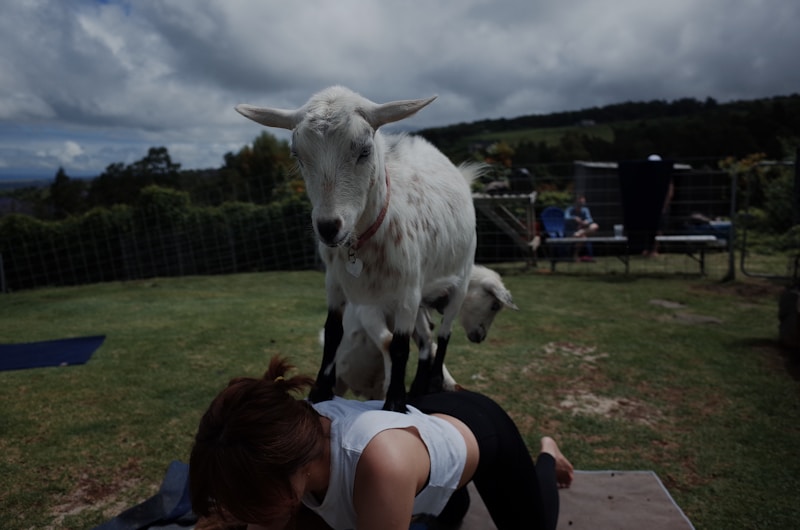Is Yoga At Risk Of Being Turned Into a Fad?
Once Doga (yoga for dogs and yoga with dogs) had proved popular – and some clever pooches even perfected their very own Adho Mukha Svanasanas – it was perhaps only a matter of time before other animals made it onto the mat.
Having said that, no one quite saw Goat Yoga coming. Domestic pets were one thing, but farm animals? Certainly it’s a zany idea, but one that speaks volumes about the new, frontier-less yoga world we live in. Whilst it may be difficult to imagine London’s pristine yoga studios introducing these cute but disruptive hoofers to class, it’s important to remember we are living in a new age of yoga. We no longer live in a yoga community dominated by studios or by dogmatic traditional practices: as more and more yogis become trained teachers, the range of yoga styles, and places where yoga is available is exploding. And that doesn’t exclude the farmyard.
From the USA with love….
While Yoga with goats has gained popularity in New Hampshire, Oregonian farm-dweller and kids’ party-host, Lainey Morse, discovered that the mothers of children attending a goat-petting party enjoyed the company of the baby goats just as much as the (human) kids did, and Goat Yoga was born. “At that party, one of the Moms was a yoga instructor”, Lainey explains. “We were all standing out in my field with the goats around us and she asked if she could have a yoga class in my field. I told her sure, but the goats will be all over the humans! I’m a photographer so we set up a promo shoot of her doing yoga with a baby goat on her back and I started marketing it as Goat Yoga. The response was amazing. I sent the pictures to Modern Farmer and they did a story on it, and then the Oregonian picked it up, and after that it just snowballed and the NYT have been out, the BBC, hundreds of others. Going viral is AMAZING!” The rest is history, and of course youtube videos.
A bigger trend: yogification
While the introduction of goats to Yoga surprised, delighted and horrified people in equal measure the world over, it’s part of a bigger trend that has also seen some other curious additions to the traditional practice that famously requires only a breathing (human) body and maybe a mat. Lately we’ve seen Beer Yoga (yoga practised with a cold one), Weed Yoga (where yogis come ‘prepared in advance’ to combine their high with poses designed to intensify it), Nude Yoga, Kilted Yoga (the Scottish cousin of Nude Yoga and Broga), not to mention Voga (yoga meets voguing), Snowga (mountainside yoga combining alpine sports with poses), and even Stiletto Yoga. It seems like anything goes, now, in the growing Yoga world.
Does this mean we’re losing traditional yoga?
Many people believe traditional yoga is getting lost in the shuffle. Radhika Vachani, Founder & MD of Yogacara Healing Arts, is an Iyengar Yoga practitioner and teacher with 17 years experience. She says, “As a yogi, it makes my blood boil. It 100 per cent dilutes the essence of yoga. People who invent these bizarre types of yoga are trying to capitalise on it and make money, which I find blasphemous.”
For those devoted to traditional practice, the fact that these newfangled yoga activities are operating under the name of yoga is offensive. Nirav Gandhi, a fellow Iyengar practitioner of 15 years practice and 10 years teaching in his native India agrees with Vachani that “these bizarre yoga practices do dilute the essence of yoga…”.
Will they last?
Whilst popularity inevitably speaks volumes at present – “Let’s not forget that if there are makers, then there are also takers for these trends”, Gandhi notes – he doesn’t think these new types of yoga will last long term. “These bizarre form won’t sustain for a long time”, he says, “we’re living in an age of consumerism. You can’t really put a stop to them as nobody owns yoga and it cannot be patented”. From personal experience, it feels as though there remains in the yoga community a tangible faith in yoga’s inherent ability to withstand commodification and dilution. In the wild world of yoga’s evolution, ultimately it will surely be a case of survival of the most enduring, and the practices at the centre of yoga philosophy have surely done a good job of proving their salt so far where that’s concerned.
A call for yogis to trust in tradition?
Yoga has always been an evolving practice, and as an evolving spiritual tradition its survival looks likely. Survival and evolution are inextricably linked, after all. The underlying spiritually philosophical approach to life that characterises yoga has pervaded many human traditions in one form or another throughout the ages, and so it’s unlikely to die out anytime soon. But the practical emphasis on specific traditional practices within yoga is also strong, and human beings have a tendency towards preserving the particular. Specific guidelines are laid out in texts such as the Yoga Sutras and it’s unlikely these will be lost. They have withstood the tests of empire, war and time, and it seems reasonable that they will also survive goats.
Survival and popularity are different
Traditional yoga doesn’t need to be ‘popular’ in the mainstream, commercial sense, in order to survive. It is not dependent upon economics or resources, but rather on individual inclination. Whether it will prove a tradition that gains or loses popularity will surely depend upon the effects of the dominant culture, and what traditional yoga offers in response to them. For centuries, it has offered a lot, and so again, there’s every reason to believe it will continue to do so, it’s just that individual inclination brings with it great subjectivity.
Yoga: a subjective experience
Yoga now caters commercially for whatever your cup of tea might be: there really is something for everyone. Whether or not this is a good thing depends on how we perceive the spirit of yoga. If it’s a way to find self-expression and enjoy feeling yourself in new and creative ways, then perhaps it’s a great new development. If you find that the thought of goats hopping about during Savasana makes your blood boil, then perhaps that’s a place to focus your yoga! If yoga is anything at all, it is surely first and foremost a subjective experience. With that in mind, perhaps there is room for everything and everyone, including goats!













